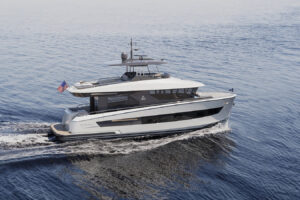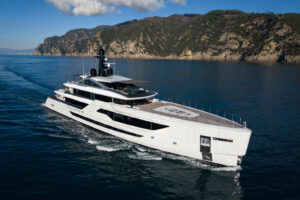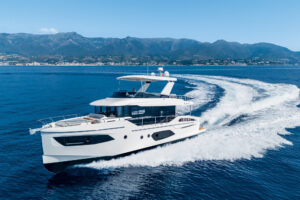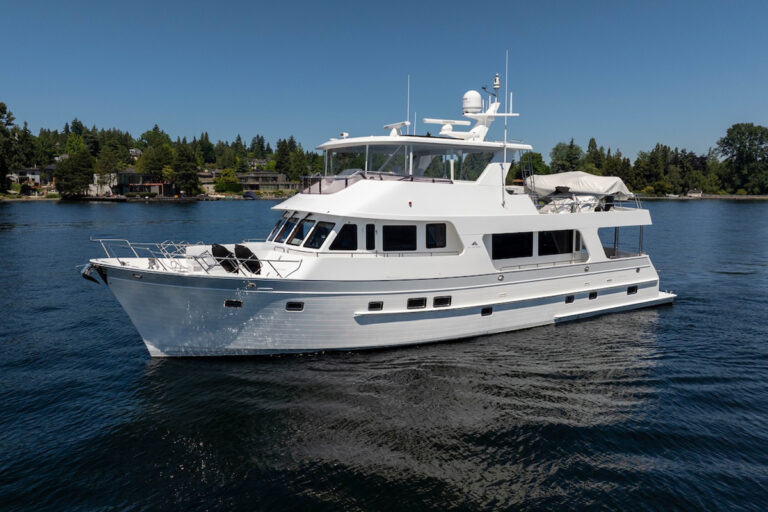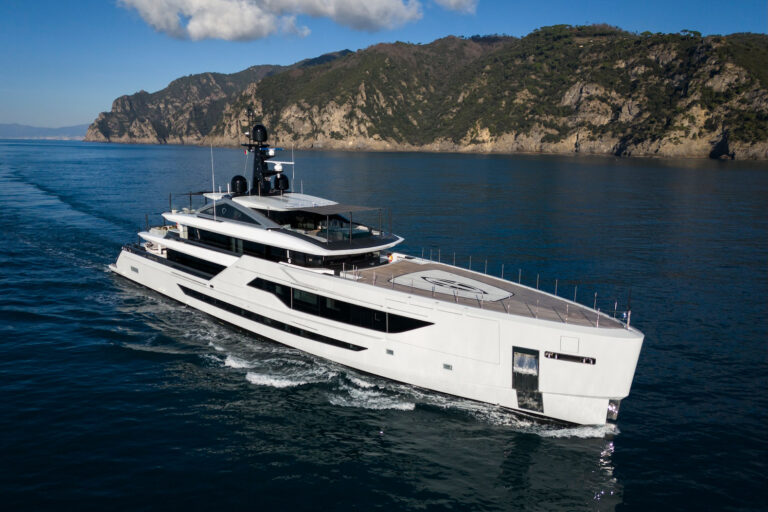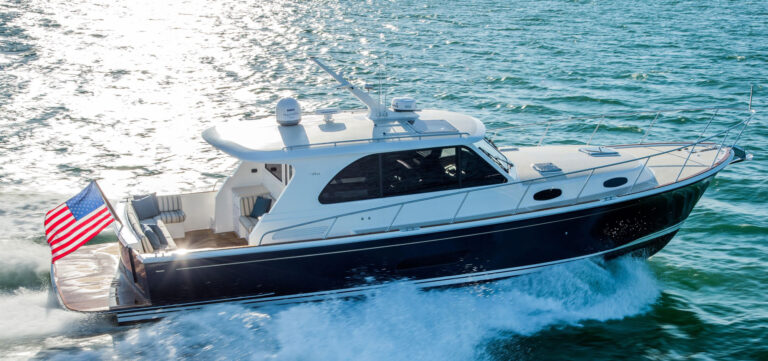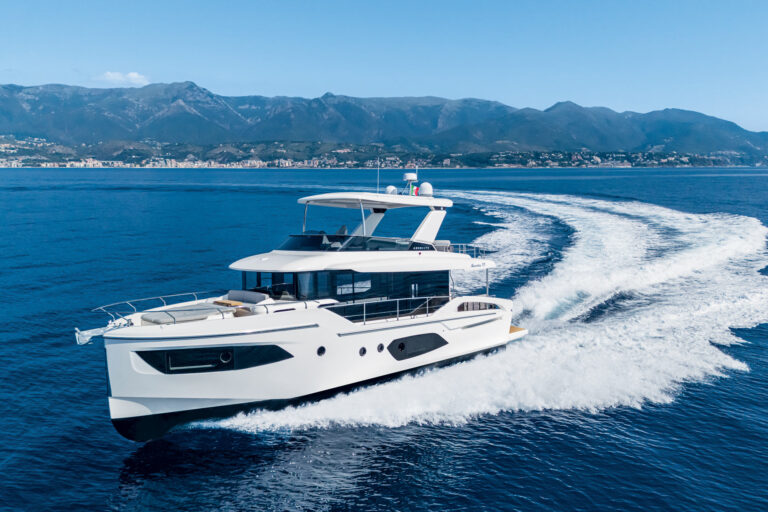Head turners in Cuttyhunk. Dock walkers in Edgartown. Hop-aboards in Menemsha. To a person they wanted to know if this was the new Surfhunter 29. Yes it was, said I, trying for modesty but not, I fear, wholly succeeding. After all, when you spend four days on what some consider the Grand Tour of the Northeast, starting and ending in Padanaram, Massachusetts, and visiting Cuttyhunk, Martha’s Vineyard and Nantucket along the way, you’re in tall cotton. And the Surfhunter 29 has a way of making you a celebrity.
At least it worked for me in Menemsha (on the Vineyard) and Cuttyhunk, where the interest came from serious sports fishermen who venture out into Buzzards Bay for stripers and farther offshore for tuna. The looks we got in Edgartown and Nantucket were from those who enjoy cruising from harbor to harbor on weekends and vacations.
Though the well-proportioned look of this new Surfhunter initially got everyone’s attention, there was much more hidden below the waterline-a modern performance-oriented hull and unique drive-train designed and engineered by the famous firm founded by C. Raymond Hunt. The classic bloodlines alone would make a Boston Brahmin salivate: Ray Hunt drew the lines for the original Surfhunter, the boat that prompted Dick Bertram to adopt the then-revolutionary, deep-V hull on the Moppie. Ray Hunt’s design firm eventually became C. Raymond Hunt Associates with John Deknatel and Winn Willard as principles. They founded Hunt Yachts, Inc., acquiring the Surfhunter line almost three years ago.
The early Surfhunters were designed to handle the fickle (some might say dreaded) waters of shallow Buzzards Bay. With no radical changes to the bottom design, the Hunt deep-V legacy remains. This latest Surfhunter has the familiar, traditional look of New England boats with signature dark-colored hulls and crowned foredecks. Though the present day Hunt firm has tweaked the original design, the V-hull still has a 21-degree deadrise, fine entry and spray-knocking lifting strakes. It’s one of the driest boats I’ve ever run.
“And it’s the hull performance that we live by”, says Peter Van Lancker, vice president of operations. “It’s the ride. It’s the knowledge that you’ll get home. It’s the comfort for your passengers. It’s the safety. It’s the fuel economy. All of which came through in our four-day cruise.”
Heading to Edgartown after leaving Cuttyhunk, the ride was a smooth one as we ran up Vineyard Sound. The next day it was on to Nantucket. On the third day we left that historic island and ran on gentle waters down the east side of Martha’s Vineyard and along the south shore to Gay Head and Menemsha. The boat performed flawlessly at 25 knots. On rough water days a slower throttle setting provided a dry and more comfortable speed in a head sea. A lot of attention has been given to trim angle. The 29 rises flat on plane and is quick to stay there from about 12 knots up. This permits a softer ride in heavier seas when slower speeds are necessary.
Our test boat was powered by a new Volvo-Penta 375-hp gas 8.1 Gi/Duoprop sterndrive system. Instead of the normal positioning of the engine all the way aft with direct linkage to the outdrive, this power train has the engine amidships for optimal hull balance and an unencumbered cockpit aft. The connection to the outdrive is accomplished with a long jackshaft. This setup prohibits use of a single fuel tank, so twin 75-gallon tanks (and batteries) are mounted aft. There’s little change in running attitude as the tanks drain. What change there is, even that caused by passenger weight distribution or winds, can be compensated for by use of the standard trim tabs.
During our cruise, we were able to crank the engine up to 4100 rpm for top speeds of over 30 knots with full fuel and three hefty men aboard. As we approached that maximum effort the noise levels created by wind and engine reached into the 90s. Company figures record a top speed of 35.5 knots at 4700 rpm. The boat was lighter then with less fuel and fewer passengers aboard.
Access to the engine for daily checks proved to be a bit of a challenge-not that I couldn’t easily reach the dip stick, oil input tube or confirm fluid levels in the freshwater cooling system. No, my problem was lifting the heavy sound-deadening hatch that covers the engine. For a person younger than this old salt with a tricky back, the task would be easy. But help is on the way. Peter Van Lancker said an electric lift-assist mechanism is in the works.
Also in the works, to spare ankles, was a change in the length and position of the footrest at the forward side of the hatch. Unlike other designs, the hatch is camouflaged with forward-and rear-facing seats and backrests.
The real advantage of these seats is their dual purpose. The aft seat is convenient as part of a conversation center for those who choose to sit on the stern cockpit seat. The hatch seat also becomes a comfortable lookout center when the stern seats are removed and the cockpit becomes an open fishing station. Anglers can watch baits seated in ease. This removable stern seat arrangement is optional.
On the forward edge, the other hatch seat becomes part of the conversation center near the helm. The hatch seats and a fore-and-aft portside passenger seat form an L-shaped settee. The helm seat can also be positioned so the helmsman can enter the conversation during cocktail hour or lunch at anchor. The two separate seating positions, one in the cockpit, the other near the helm, are a design feature that didn’t go unnoticed by our dockside onlookers.
And it’s at anchor in a quiet cove that the interior design comes into play. A galley with microwave to port, a head with faucet shower to starboard, hanging locker and V-berths complete the setup. Headroom varies from full, stand up at the galley to just under six feet over the bunks.
The helm station’s essential dials, instruments and VHF- radio are within easy reach. The one necessity is the need for a combination navigation system that employs a single display screen to show electronic charts, fishfinder images and waypoint steering instructions. We had the Garmin 2010C on board with detailed BlueChart cartography. This unit has a 10.4-inch color screen upon which all other data can be displayed. Furuno, Raymarine, Northstar and Simrad all have such combo systems.
When Hunt Associates and Peter Van Lancker developed this new 29-foot design, they recognized the need for a “value package. The selection of a single-engine model was no mistake. Neither was the decision to offer an optional bow thruster; the thruster makes docking and undocking the 29 a snap, even in the most trying wind and current conditions. Be sure to get one.
But even without it, the Surfhunter 29 is a price-conscious package with the standard 320-hp gas Volvo. You can cruise and/or fish in a standard, well-found boat that will cost you about $155,000. An extensive list of available options includes side curtains and mooring cover, swim platform, exterior teak trim, stereo and, of course, navigational electronics. Engine options also available include our 375-hp gas, a 310-hp diesel (both sterndrives), and a 315-hp diesel inboard with V-drive. There’s even a jet drive on the drawing boards.
The only doubt in my mind about the Surfhunter 29 is whether the ghost of C. Raymond Hunt came along for the ride. Perhaps the only way to know for sure is to take the Grand Tour yourself sometime.
Contact: Hunt Yachts, (508) 994-2036; www.crhunt.com.

